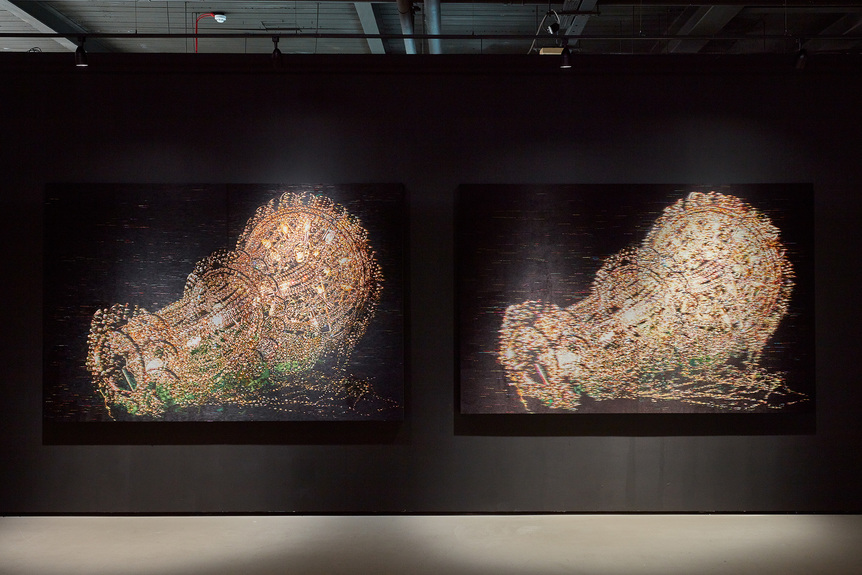-
From Current Issue
-
- Editor’s Letter Fire in the Heart
- Reviews I Gusti Ayu Kadek Murniasih
- Reviews 11th Seoul Mediacity Biennale: “One Escape at a Time”
- Dispatch Networked China
- One on One Monira Al Qadiri on Yukio Mishima
- Essays The rise of independent art spaces in pandemic-era Shanghai
- Features Tuan Andrew Nguyen
- Table of Contents
- Web Exclusives
- Archive
- Subscribe

R
E
V N
E
X
T
Installation view of “The Real DMZ Project: Negotiating Borders” at the Korean Cultural Centre UK, London, 2019. All photos by Dan Weill Photography; courtesy Korean Cultural Centre UK.
Contrary to its name, the demilitarized zone between North and South Korea is one of the most heavily militarized areas in the world. Since 2012, the South Korea-based Real DMZ Project has sought to explore the meanings and ironies produced by this space through research, dialogue, and exhibitions. “Negotiating Borders,” the project’s latest show at the Korean Cultural Centre UK in London, had elements capable of arousing both curiosity and emotion, but lacked a strong curatorial thesis—either visual or textural—to make it as effective as it might otherwise have been.
The most notable works tended to be photographic. Seung Woo Back’s Blow up (2006), which covered a partition in the main gallery, is a fascinating study in repressed emotion. During a 2001 trip to Pyongyang, where the photographer was, of course, monitored and chaperoned, Back came to believe that his pictures would be disingenuous and banal. Years later, recognizing the face of one of his subjects in another photography exhibition prompted him to revisit his originals. Re-examining the staged tableaux, he started to notice cracks: a smile that looks just a little too forced; a person in the background not intended to be part of the photo op. Presenting these images enlarged on the wall, Back invites us to see the same, and our time and attention is rewarded with ever sharper human detail.
Elsewhere, Heinkuhn Oh presented a series of photographic portraits of South Korean soldiers. Each shows a soldier standing or sitting with a facial expression that can only be described as exhaustion. These were put into relief by the one exception: A laughing sergeant and a private E-2 at attention, October 2010 (2010), in which the superior officer seems almost too gleeful, distastefully so, in unsettling contrast to the overly—or, perhaps, appropriately—somber younger subject.
Installation view of HEINKUHN OH’s (left to right) A laughing sergeant and a private E-2 at attention, October 2010, 2010, archival pigment print, 128 × 169 cm; A soldier with a solid body, July 2011, 2011, archival pigment print, 126 × 99 cm; A corporal on red clay, May 2010, 2010, archival pigment print, 123.5 × 155 cm; at “The Real DMZ Project: Negotiating Borders,” Korean Cultural Centre UK, London, 2019.
Of the more sculptural or conceptual works, Kyungah Ham’s What you see is the unseen / Chandeliers for Five Cities (2016–19) series of black textiles embroidered with the ornate light fixture were nothing short of extraordinary, and especially valuable for their inclusion of materials that were at least partly made by North Korean hands. The artist had been inspired to initiate the project after she encountered propaganda flyers from the North and began imagining the possibility of contact with the unknowable people there. Through intermediaries in China and Russia, she delivered digitally produced texts and images to craftspeople in the North, and what came back were extremely labor-intensive broidery works. However, perhaps the most telling element of the work, though easily missed, was to be found in the accompanying list of materials: “North Korean hand embroidery, silk threads on cotton, middle man, smuggling, bribe, tension, anxiety, censorship, ideology, wooden frame, approx. 1,600 hrs/2 persons.” Socially or politically conscious art that truly makes the effort to acknowledge its subjects is vanishingly rare; this work faced more obstacles than most, and does better at it. It is worth adding (though this was not referenced in the exhibition) that the North Korean tradespeople are paid; how much and in what form given the scarcity of North Korean won is unclear.
Installation view of LEE BUL’s Study for Aubade V, 2019, casted steel (collected from demolished check point in DMZ), glass beads, printed circuit board, electronic components, black board, brass angle, Optium museum acrylic, light bulb, paints for stained glass, coated steel wire, nickel wire, electric wire, high solid gel, 80 × 50 cm in diameter, at “The Real DMZ Project: Negotiating Borders,” Korean Cultural Centre UK, London, 2019.
In contrast to Ham’s standout pieces was a disappointing model for a work to be created by Lee Bul entitled Study for Aubade V (2019). The final piece will be produced from melted barbed wire taken from guard posts in the DMZ and form a large-scale installation after the designs of modern lighting towers from various eras and sources. While the use of materials is on message in a very superficial way, claims of inspiration from Bruno Taut’s Monument des Neuen Gesetzes places this squarely in the context of much of Bul’s other work, and thus undermine its thematic or situational specificity here, especially when compared to more appropriate or thoughtful offerings elsewhere in the exhibition. This inclusion was an example of lapsed curatorial coherence that made this show—however interesting in its variety—ultimately no more than the sum of its parts.
Ned Carter Miles is ArtAsiaPacific’s London desk editor.
“The Real DMZ Project: Negotiating Borders” is on view at the Korean Cultural Centre UK, London, until November 23, 2019.
To read more of ArtAsiaPacific’s articles, visit our Digital Library.




















